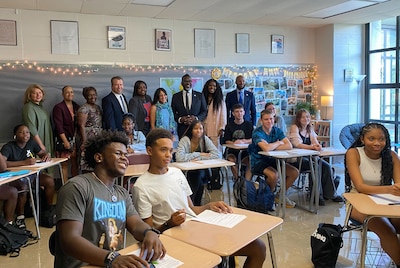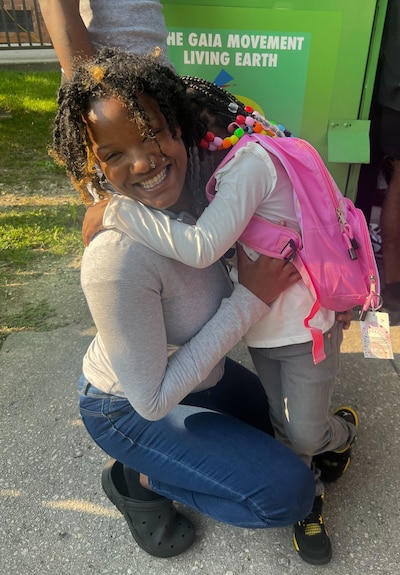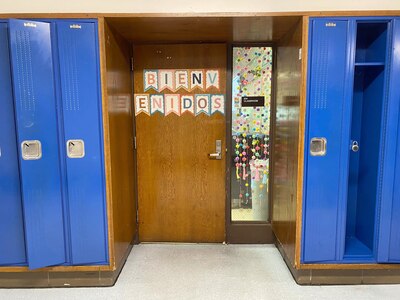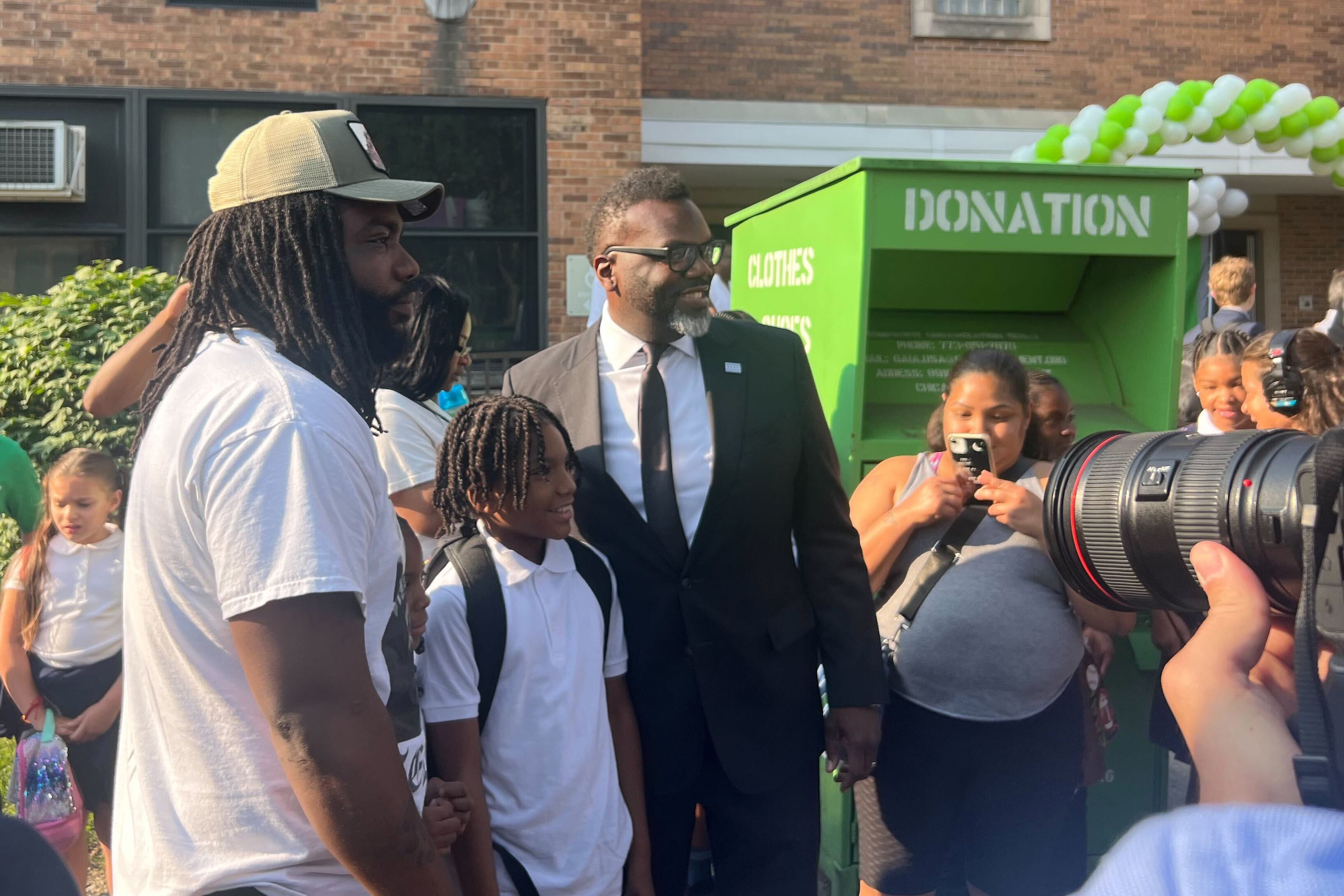Chicago Public Schools is officially back in session.
Mayor Brandon Johnson, the first Chicago mayor in recent history to send his children to public schools, kicked off the first day of classes by joining educators, Chicago Public Schools CEO Pedro Martinez, and Chicago Teachers Union President Stacy Davis Gates outside Beidler Elementary School on the West Side.
Under a sweltering sun at 8:30 a.m., Johnson greeted parents and children in front of a chorus of reporters and cameras, before ringing the ceremonial bell to start the school year.
The joint appearance with Davis Gates, Martinez, and other district and union officials was unsurprising for the union-friendly mayor who came up through the CTU’s ranks, but still a break from the past when the union and City Hall officials would visit schools separately.
Despite the district facing a number of challenges ahead, including unreliable bus transportation, ongoing enrollment shifts, and an influx of immigrant students, Johnson focused on a new era of collaboration at the city’s public schools.
Later in the morning, after touring two other campuses, Johnson visited Kenwood Academy, where his son is now a sophomore.
Speaking to a history class, he likened the first-day icebreakers the teacher was doing to what he’s doing as the city’s new mayor.
“I hope that you will lean into the collaborative approach that your teacher is taking, because that is what we’re doing as a city,” Johnson told the students. “We’re building relationships, we’re collaborating so that we can make collective decisions together that ultimately can help transform people’s lives.”

CPS claws back from enrollment losses
Visiting Beidler was a symbolic choice for the mayor. The school narrowly escaped closure about a decade ago and is now part of a program Johnson wishes to expand: the Sustainable Community Schools initiative, which aims to provide wraparound services and more programming for students and families.
But Beidler is among several other schools in the program that have lost at least a quarter of their enrollment since the initiative started.
The official enrollment count will not be known until after the 20th day of school in September. But last year, 80,000 fewer students were enrolled in Chicago Public Schools than there were a decade ago and it is now the nation’s fourth largest school district. Chicago’s declining enrollment predated the emergence of COVID-19, but continued during the pandemic.
And for many parents and kids arriving at Beidler Monday morning, more pressing thoughts — like wishing for a great year — were at the forefront. Dondneja Wilson hoped that her daughter, who started preschool, would “grow, and learn, and have fun.”
“She likes kids a lot, so I feel like that’s going to be her favorite part,” Wilson said.

Last year, data from the last day of school in June obtained by Chalkbeat showed little change in overall enrollment. However, the number of English learners grew by more than 5,000 students. District officials have pointed to the increase as an approximation of how many migrant students have arrived on buses in the past year.
Chicago is seeing an influx of newcomers, many of whom are seeking asylum, arriving by bus from the southern border in Texas.
The number of bilingual teachers in CPS has dipped since 2015, even as the English learner population has grown, according to a recent Chalkbeat analysis. While 6,900 teachers have earned bilingual education endorsements — more than ever before, according to the district — it’s unclear how many are actually assigned to teach bilingual education.
Educators and immigrant advocates have expressed concerns about whether schools can properly support these new students. Jianan Shi, president of the Board of Education, said the city’s new welcome center for migrant students on the West Side has enrolled “hundreds” of newcomer students. He’s requested more information on the system’s overall strategy for supporting newcomers.

Outside Beidler, CPS CEO Pedro Martinez told reporters that “the biggest challenge” is ensuring that all newcomers are registered in school, but he said the district is well-positioned to serve them, noting that Chicago has one of the largest bilingual and dual language programs in the nation. About one-fifth of the city’s students are English language learners.
“The challenge we have right now is, again, keeping up with all the new asylum-seekers that are coming in, going to them, making sure that we’re able to register them, assess them,” Martinez said. “But we’re doing that as we speak now.”
Transportation woes continue on first day
Transportation woes that have plagued the district for the last few years also cropped up on the first day, as parents reported problems with bus routes and trips that took more than an hour.
Laurie Viets, a CPS parent of three children – two of whom have transportation written into an Individualized Education Program – said the district promised to have all transportation issues resolved by last Friday.
However, Viets found out on Friday that one of her children, a seventh grader, was not going to have transportation and another child, a first-year high school student, would have a long bus route. Today, it took 70 minutes to get to school; it’s normally a 12-minute car ride, Viets said.
Viets said she wished Chicago Public Schools would have given her more time to prepare for changes in the transportation plans. Now, she won’t have transportation for one of her children for up to two weeks and she is concerned that her other child will be on the bus without air conditioning in extreme heat until they shorten his route.
The district’s bus problems stem back to 2021, the first year back to full-time, in-person school after COVID forced CPS to close buildings in March 2020. Students were left waiting on the first day and beyond for buses that never showed. In emergency mode at that time, the district began offering $1,000 stipends for rideshare services such as Lyft and Uber. But the transportation troubles continued well into the school year.
Last year, some 365 students were waiting for bus routes the first week of school and in September, district officials said they were still working to reduce 90-minute rides for some students.
The district has blamed and continues to point to a nationwide bus driver shortage as causing the transportation troubles. It signed a $4 million contract with a longtime vendor and bus-routing software company to try to fix the issues.
But last month, on July 31, district officials announced that it would not be able to transport roughly 8,000 students on the first day of school. They offered $500 monthly stipends to families of CPS students with disabilities or those in temporary living situations. Both groups are legally entitled to transportation. The district said at the time that 3,000 students had chosen the stipend option.
Davis Gates called the transportation troubles “a disaster” and a “failure of privatization.” CPS contracts with private bus companies to provide students with transportation. Davis Gates said she would like to see the district bring busing “in-house” and experiment with having its own fleet of buses that could start small by covering field trips and sporting events and then grow.
“These are Band-Aid approaches. I have not seen anything transformative or revolutionary in this space. And again, three strikes you’re out,” she said. “This isn’t a good way to start the school year with respect to transportation.”
The district has previously increased pay rates for bus driver companies, and is hoping to do so again this year. Martinez said he hopes that will help fill the driver shortage.
Viets, the parent worrying about her children’s transportation, said more needs to be done.
“Next year, if CPS is going to start by Aug. 21, by Aug. 1 they should know what the routes are,” said Viets.
If Chicago finalizes plans the Friday before the start of school, she said, the district is “not giving parents any kind of respect at all. They’re not giving us an opportunity to make other plans when they mess up.”
As Viets noted, the extreme heat also adds to worries about long bus rides. The weather also raises concerns about conditions inside buildings once students arrive.
Air-conditioning, aging buildings prompt push for green schools
With temperatures expected to reach 100 degrees this week, Martinez said his team worked “around the clock” to ensure classrooms are equipped with air conditioning this week.
Martinez said every classroom has at least a window unit, a key union demand during the CTU’s 2012 strike that was implemented a couple of years later by then-Mayor Rahm Emanuel. Still, in some cases, hallways are not air-conditioned, Martinez said.
Johnson has touted “climate justice” as a key focus of his administration and reiterated Monday that includes schools.
“Having buildings that are retrofitted, as well as an economy that’s built around green technology, some of that is top of mind,” he said.
Davis Gates used this week’s weather forecast to illustrate climate change’s impact on the city and why it underscores the urgent need for a new CPS facilities master plan, which hasn’t been updated since 2018. She added that building greener schools will be one issue the union will bargain over ahead of its contract expiration in 2024.
The school calendar’s pre-Labor Day start is an issue Davis Gates would immediately bargain over, she said. The late August start date began in 2021, matching up with many suburban districts.
The union was not able to bargain over the school calendar in 2019, Davis Gates said. But the passage of a 2021 state law reinstating some of the CTU’s bargaining rights could allow the calendar to be back on the table. The union’s contract expires next June and it’s likely the district and new mayor will begin negotiations with the teachers this winter.
The larger issues that officials highlighted were likely not top of mind for many students, such as 5-year-old Pierre, who started kindergarten at Beidler.
Asked what he was most excited about this school year, Pierre replied, “Playing.”
Reema Amin is a reporter covering Chicago Public Schools. Contact Reema at ramin@chalkbeat.org.
Becky Vevea is the bureau chief for Chalkbeat Chicago. Contact Becky at bvevea@chalkbeat.org.
Samantha Smylie is the state education reporter for Chalkbeat Chicago, covering school districts across the state, legislation, special education, and the state board of education. Contact Samantha at ssmylie@chalkbeat.org.







